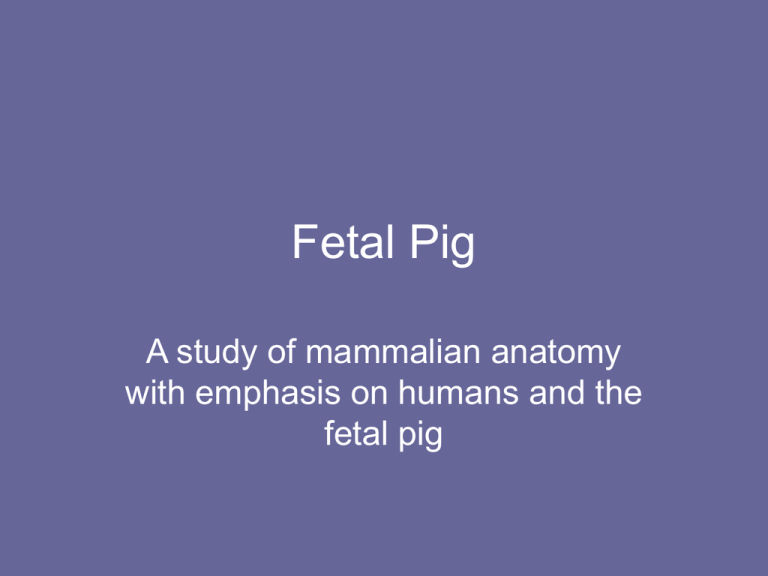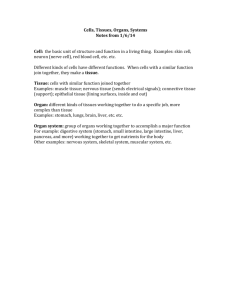Fetal Pig
advertisement

Fetal Pig A study of mammalian anatomy with emphasis on humans and the fetal pig Taxonomy • Kingdom Animalia • Phylum: Chordata (backbone/spine) • Class: Mammalia • Order • Genus: Sus • Species: scrofa • When naming an animal scientifically you would use that animal’s genus & species. • Ex. This type of pig is Sus scrofa. Fetal Pig • Fetal = fetus: a stage in animal development. A well developed zygote. External/Head Region • • External structures *There are 3 major regions of the pig’s body. Head, trunk & tail. • I) Head region – usually considered the front or top of a species. Usually contains the brain & most sense organs 1) Eyes (2) – sight organs.(#3) 2) Jaw – a bony area of the head that contains the teeth (#5) 3) Snout – the pig’s nose used for smelling & digging (#4) 4) Ear – organs used for hearing. May be called Pinnae (#1 & #2) – – – – External/Trunk Region • B) Trunk – the midsection of a mammal. It is broken into 2 sections, the thorax (upper trunk) & abdomen (lower trunk). – Legs- front & hind. Used for movement – Umbilicus (umbilical chord) – small tube that connects the fetus to the mother’s uterus. Used to feed the baby in the womb.(#6) – Nipples – on males & females, but often more on the female pig. Used to feed the young milk. (#10) – Reproductive organs – For reproducing. • a) Male- penis & scrotal sac. (May not be outwardly visible.) (#9) • b) Female – Vagina – Anus – pore used for eliminating solid waste from the body. (May be considered part of the tail region as well.(#11) External/Tail • Tail – the back of some species. A tail can be used for anything from swatting pests & grasping objects to attracting mates & distracting predators. The Internal Structures • All internal structures will be put into body systems. • The systems will include: – Digestive/Excretory – Urogenital/Reproductive – Respiratory – Circulatory – Nervous – Skeletal – Muscular *Not all systems or organs will be mentioned Digestive/Excretory Systems • Digestive/Excretory system – converts food to energy for the body’s use & removes waste from the body. – Liver – organ that removes waste from some foods. (detoxification) It also stores bile. Usually brown. – Diaphragm – muscle between abdominal & thoracic cavities that separates them & puts pressure on lungs & esophagus. – Tongue – taste organ with 4 taste buds on it. ( sweet, sour, salty, bitter) – Esophagus – muscular tube behind the tongue that connects mouth to stomach. – Stomach – stores & digests food using enzymes & stomach acids. – Small intestine – smaller tube that connects stomach to large intestine beginning of waste removal (excretory system). – Large intestine – also called colon. Waste removal is its function. – Rectum – a muscle at the end of the large intestine that pushes feces (solid waste from the body) out. – Anus – an external feature but a pore where the waste leaves the body. – Gall bladder – small greenish structure behind the liver. It contains bile & helps detoxify food. – Spleen – connected to the stomach. It makes white blood cells so it is actually part of the circulatory system. Long & thin. – Pancreas – in the mesentery (web-like connective tissue) behind stomach. Usually it is gray & bumpy & has enzymes that aid in digestion. Urogenital & Reproductive Systems • • • • Urogenital & Reproductive systems – to remove liquid waste & reproduce offspring Urogenital – Kidney – bean shaped organ on the wall of the back that removes excess salt, H2O, & urea (nitrogen waste) from the blood. – Ureter – small tubes that empty the kidneys to the bladder. – Bladder – the bulb-like sac organ that stores urine until it is ready to be removed. – Urethra – a tube that empties urine from the bladder out of body. Male reproductive system – Penis- male reproductive organ – Scrotum – sac that protects the testes. – Testes – 2 male oval organs that produce sperm. Female reproductive system – Vagina – female reproductive organ. – Ovaries – 2 small round organs attached to the back produce egg cells. – Oviduct (Fallopian tube) – 2 tubes that connect ovaries to the Uterus for fertilization. Pig has Uterine horns (extensions that help mammals with multiple births). – Uterus – a sac where fertilization takes place & the fetus is nurtured. The Urinary System Reproductive Diagrams Male Female Respiratory System • Respiratory system – brings in oxygen & removes carbon dioxide. – Mouth- where air enters. Tongue & teeth are in the mouth. – Pharynx – a cavity that has the organs for breathing. • Larynx – voicebox • Trachea – windpipe. Ringed cartilage. – Lungs – 2 organs that exchange gases. Circulatory System • Circulatory system transports, blood, oxygen, & nutrients to the body. – Blood vessels – carry blood • • • – Veins –smaller blood vessels bring blood back to the heart from the body. This blood contains little or no oxygen. Arteries- larger blood vessels that carry blood with oxygen from the heart to the body. Capillaries – small connecting blood vessels. Heart- muscular organ that pumps blood to the body. Nervous System • Nervous System – controls body’s senses functions, & actions. – Brain – the organ that controls all the body’s functions, the nerve center. – Spinal Chord – nervous tissue behind the backbone. Like an electrical wire to the rest of the body. Sends signals from brain to body’s nerves. Skeletal System • Skeletal system – Protection, movement, & support. • All bones (humans 206) & cartilages (soft bone) are part of this system Muscular System • Muscular system – for movement & insulation. • It includes all ligaments (muscle to bone) & tendons (muscle to muscle) (connective tissues).








